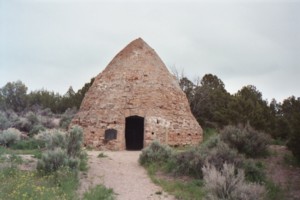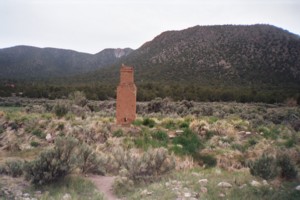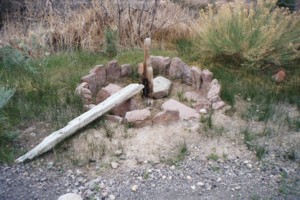This article may include affiliate links. If you click a link and make a purchase, Utah Outdoor Activities may receive a small commission at no extra cost to you. We only recommend products or services we personally use. FTC Affiliate Disclosure.

During the 1850's in hopes of increasing the self- sufficiency of Utah, Brigham Young sent members of the Church Of Jesus Christ of Latter Day Saints to the Iron Mission in what is now Cedar City, Utah. Approximately ten years after the iron works of Cedar city closed, Peter Shirts discovered the site of Iron City. In June of 1868 Ebenezer Hanks organized the Union Iron Company.
By 1870 the population of Iron City had reached 97. The growing city then contained a foundry, machine shop, brick schoolhouse, blacksmith shop, and a pattern shop. Although Iron City seemed prosperous, the Union Iron Company was unable to overcome the obstacles created by the money panic of 1874, and the lack of efficient transportation to the outlets in Northern Utah. The iron operation closed in 1877.
Charcoal Kiln:
Pinyon and Juniper wood was burned in this kiln to produce a porous residue made up of pure carbon. This residue was then burned in the smelting process where it produced an intense heat without smoke. After the kiln was filled to the upper door with wood, the fire was started in the center at the bottom of the kiln.
 The fire was then drawn to the top of the kiln by unsealed space that was left open around the upper door. When this space was closed the fire was regulated by vent holes. This burning of the wood lasted three to seven days.
The fire was then drawn to the top of the kiln by unsealed space that was left open around the upper door. When this space was closed the fire was regulated by vent holes. This burning of the wood lasted three to seven days.
Furnace and Foundry:
The chimney and rock walls are the remainders of the furnace and foundry buildings. The depression that runs underneath the remains of these walls is a ditch that was used to divert water from Little Pinto Creek into the foundry building.
Large Furnace:
This structure was meant to be a second, larger furnace. The furnace was never completed.
Spanas Arrastra:
In the Arrastra, or grinding stone, iron ore was reduced in size so that it could be used to charge the furnace. From the center post of the Arrastra, a long tongue extended to a hitched mule. The mule pulled a large stone.
 This stone moved over the ore, reducing it to the desired size of 2 inches long. This device was also used to reduce sandstone from the New Harmony area into sand. The sand was used in the molding house.
This stone moved over the ore, reducing it to the desired size of 2 inches long. This device was also used to reduce sandstone from the New Harmony area into sand. The sand was used in the molding house.
Location:
From Cedar City, head west on Highway 56 for approximately 20 miles. Turn south onto Old Iron Town Road. Take this graded gravel road for approximately five miles to the ruins.
Related Articles:
Frontier Homestead State Park & Museum
Nearby Lodging: (Affiliate Links)
We hope you enjoyed this information. For more outdoor activities, please connect with us on YouTube, Facebook and Instagram. Help us keep this site up and running by visiting our online store which features outdoor themed gifts, decor and more. Thank you for visiting and for your ongoing support!